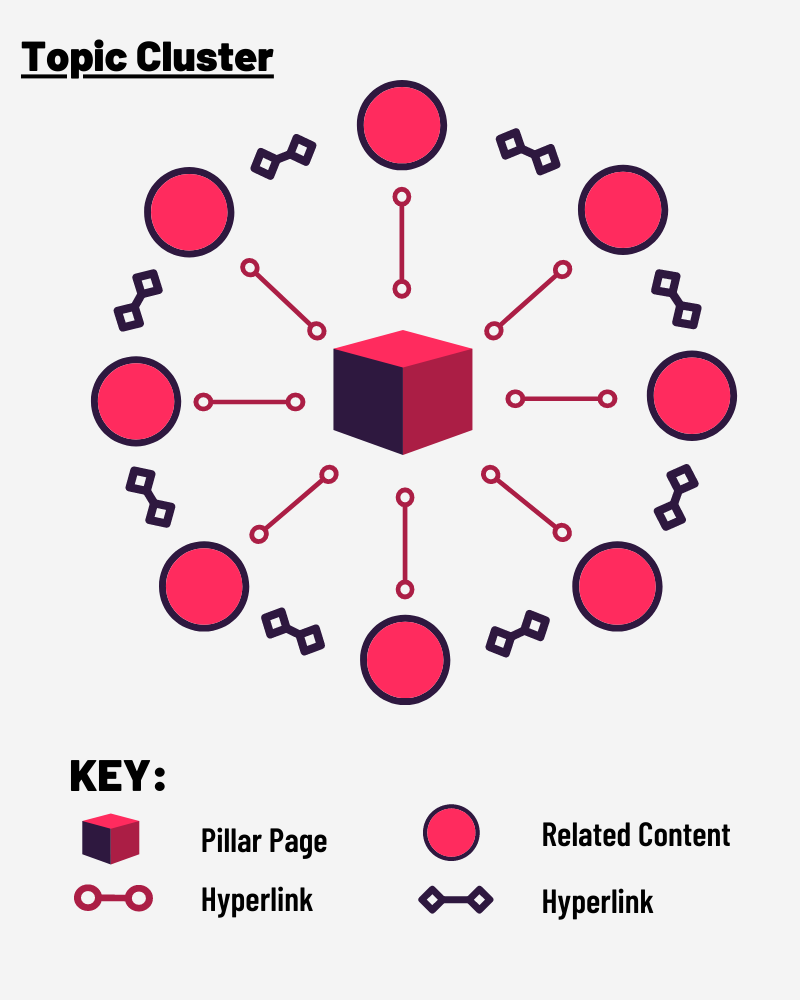
-
Joshua Lee
- 4 Min Read
- Blog, Content Creation, SEO
How To Master Topic Clusters And Pillar Pages
We love chatting about topic clusters and pillar pages here at ROAR, and it’s a technique many digital marketers are yet to understand fully, implement, and truly master.
What is a topic cluster?
Widely hailed as the next evolution of SEO, topic clusters are an emerging search engine optimisation technique. Highly content orientated and very specific to key focus areas topic clusters are a highly efficient method of rising to the top of SERPs.
A topic cluster is made of a pillar page optimised for a broad topic and several related pieces of content hyperlinking back to the pillar page and one another. Imagine the pillar page as the centre of the cluster and the related content surrounding the centre connected via inbound hyperlinks. Check out the diagram below for a better idea of the structure of topic clusters.
What are Pillar Pages?
Pillar pages are the foundation of topic cluster strategy. They are highly detailed pages on your website with lots of quality content around a broad topic with the intent of building authority and driving sales opportunities.
As an example, think of an animal welfare charity, a broad topic they may want to build authority for could be puppy welfare and training. In this instance, the charity would create a pillar page ranking for this broad term, ‘puppy welfare and training’, and then develop a content strategy surrounding related keywords and key phrases like ‘When should I feed a new puppy’ or ‘When can I take my new puppy outside?’. All of these related keywords are then to be published and linked back and from the pillar page.
Instead of one fisherman casting one line you effectively become a trawler, casting a large net and bringing in a massive haul of traffic.
Mastering The Topic Cluster
1. Carry out an audit.
To begin your bold new venture into the world of topic clusters and pillar pages you may want to consider a content audit of your current site. Google loves fresh content and dislikes outdated content. Get the best start you possibly can by taking stock of your current content, keywords and copy.
2. Pick A Good Broad Topic.
The topic keyword will be the foundation of your topic cluster, ensure that the broad topic is a good one. Link your broad topic keyword to your business objectives and KPIs, after all, you’re aiming for the number one spot to convert the traffic and or build domain authority to become topical thought leaders.
3. Get researching!
Your chosen keyword research tool is going to be your best friend in this step, so pick something you can rely on, like our DIY SEO software tool. Find the best possible related keywords to build your cluster content around, aim for high competition keywords that will be harder to rank for and focus on user intent. This will boost the pillar page significantly.
4. Write your content.
Start writing that content! Create your targeted cluster content, all of which should cover the related topic keyword in-depth, the more detail the better. We can’t stress that enough, for real results your related cluster content must be detailed and heavily so.
5. Start linking your topic clusters and pillar pages.
Before publishing your related topic cluster content ensure that they link back to the pillar page and also into one or two other blogs across the cluster, refer to the diagram at the beginning of this post if you’re not sure what we mean. Then get publishing and posting! Try and think back to the fishing net metaphor before you do this, are there any weak spots in your net? Make sure you’re prepared before you implement your topic clusters.
Why You Should Master Topic Clusters And Pillar Pages
If we haven’t quite sold you on topic clusters and pillar pages yet allow us this quick little paragraph to conclude. To be as blunt as possible, you should be mastering this technique because it is the new kid on the block and the results speak for themselves. Just look at HubSpot who, since implementing topic clusters of their own have grown their organic blog traffic from 500 visitors per month to nearly 190,000! That’s a whopping 37,900% increase, turning their blog into a money-making machine!
If you need a little more help with getting started, check out our post on how to create a topic cluster or if you need a little bit more convincing check our post on why topic clusters are your best SEO tool
We know this may seem like a lot, especially for smaller businesses the pillar page alone will take a lot of work to complete. Luckily, we have the perfect solution for you! The latest innovation from the ROAR team is the SEO Bomb® , a full-service product that will develop a tailored SEO topic cluster strategy.







